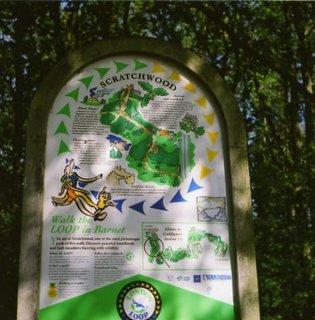Who steals the goose from off the common
But leaves the greater villain loose
Who steals the common from the goose.
Ah, Elstree. Is it because it is the end of the Eles Street, the ancient road that we met at Fryent Country Park (see the dead fox picture)? Of course, last time I covered it I did the studios, which are actually in Borehamwood. The Gate Studios have now been demolished since then (I don’t know why as they were used for producing cinema screens: perhaps the cinema building craze has stopped) but I left the station to walk up a street past some film star houses and even some film star flats called ‘Hollywood Court’. It’s great to be back on waymarked paths which make the guidebook redundant. The walk went up a long steep hill then turned into another lane with even bigger film star houses and a slightly steeper gradient. I suspect these houses are now occupied by rice merchants from Park Royal or slum grocers, who seem to be the millionaires now.
I passed by two air shafts for the Borehamwood Tunnel quite close together then descended into the Scratchwood local nature reserve. Every boy from the north who looks wistfully at London has heard of Scratchwood, as it is the last motorway service station on the way from the north. However they may not reach the wood itself (although they might, they’re intrepid those boys) which was quite pleasant as woods go. All the blackberries have now gone to the devil even before Michelmas. He seems to have claimed them early this year for some reason.

Scratchwood was part of a shooting estate but covers some very ancient oak woodlands. They seem a lot better managed than some other woods and the brambles appeared to be cleared quite well. It was a pity that the woods didn’t last very long and I had to go down to the A1(T) which is no longer the Great North Road but at this section is Barnet Way as it is the Barnet By-pass. I had to go a fairly long way down the road to cross by a subway next to the Mill Hill Golf Club (Memberships available - no joining fee!) and then walk back up to reach Moat Mount open space, which was a shooting estate, its mansion long gone and the grounds sold to Barnet Council. I walked up a little stream here and then came out into some open fields with wired off pathways, including some that were only permissive and not public rights of way. There were horned cattle in one field, but very few of them. I didn’t look too closely but I think they were bullocks rather than milkers. I came to another dangerous road and then walked through the London Wildlife Trust Totteridge Fields and crossed a football field and onto the Dollis Brook way. We have encountered the Dollis Brook on the Capital Ring but only slightly. In two of the fields I passed there were fairs going on. The first one I came upon looked like a horse fair with gypsies doing deals on horses and some finely painted gypsy caravans and carts. The other one was more a travelling funfair, perhaps it was Barnet Fair. Barnet fair is cockney rhyming slang for hair (abbreviated to Barnet) and there is a hairdressers near me called Barnet Fair.
After open countryside the Dollis Brook Way (and the London Loop) pass by various council estates which you can date by the manner of construction – 1950s brick, and 1960s prefabrication. Coming into Barnet proper I joined the Great North Road (although alas the little coöp shop has gone so I had to go elsewhere for my lunch) and went straight off it again to cross King Georges Fields. These appear to be named after King George V and possibly purchased for his Silver Jubilee in 1935. These fields were so secluded I took off my T shirt and had a brief sunbathe. There were also views over London although not particularly clear.
The Fields led me to Hadley Green where the battle of Barnet was fought on Easter day 1471. Edward IV overthrew Warwick the Kingmaker who was killed here. As it was a misty day, the soldiers could not see which side they were fighting and chaos ensued. General battle conditions I would have thought. If you wanted to be king in the middle ages you applied to Warwick the Kingmaker (in own handwriting) giving name and names of father and mother (if nun write none). Seller and Yateman ride again. Hadley has some very fine houses on its green including an old manor house with a very fine front door and a turret on its stable block. Not so large but very unassuming is a row of six tiny cottages with paired front doors built in mellow brick – the Sir Roger Wilbrahams Almshouses. Sir Roger was Solicitor General of Ireland in the time of Queen Elizabeth I and he founded his homes for six decayed housekeepers here in 1612. The current residents may have a quiet laugh about that.
There is a pleasant scene by the church with old cottages and the beacon on the church, erected to guide travellers over the wilds of Enfield Chase. The Monken Hadley common is the remains of Enfield Chase which was enclosed in the 1770s and is gated. I had to pass through the white painted gate to continue past some more very large houses to descend into the woods of the common. These woods were quite muddy and I got my boots coated. I soon got to Cockfosters though via more large houses on the common. Cockfosters had a 19th Century church and a 1930s-1950s underground station which proved very serviceable indeed to getting me home after a very pleasant walk indeed. Even the weather was kind.


No comments:
Post a Comment